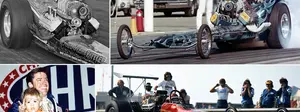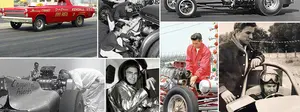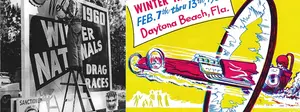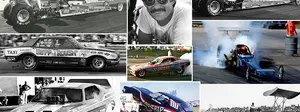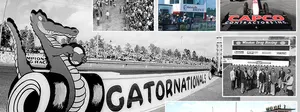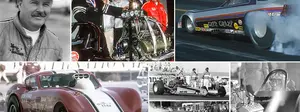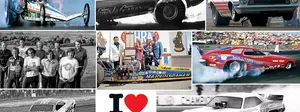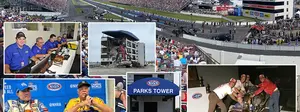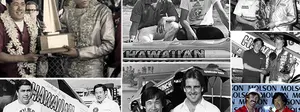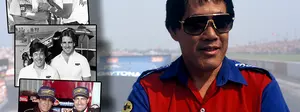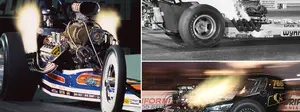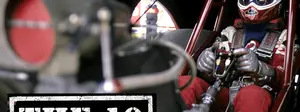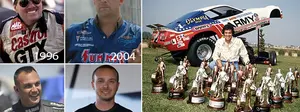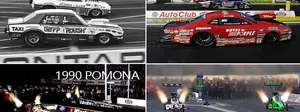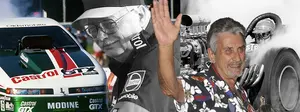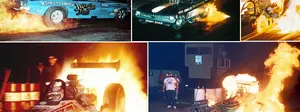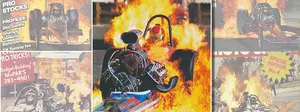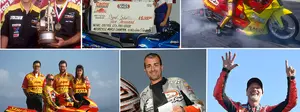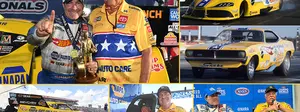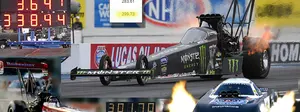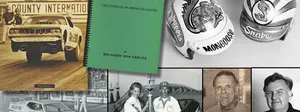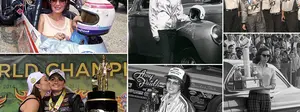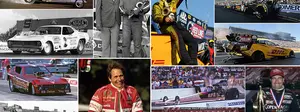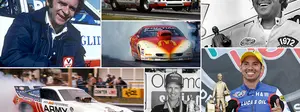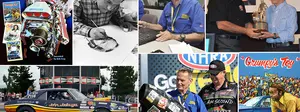Funny Car performance, then and now
 |
 |
If you are a fan of the Funny Car class – and hey, who isn’t? – the 2015 season was a spectacular one, not just for its dramatic finish on the final day of the schedule last Sunday in Pomona, but also for scoreboard watchers.
Consider this: The quickest run in Funny Car entering 2015 was 3.959, recorded by Cruz Pedregon at the 2014 Englishtown event. We finished this season with Matt Hagan’s 3.879 as the all-time quickest pass. That’s a drop of eight-hundredths of a second. And Pedregon’s run was bettered not just once or twice, or a dozen times, but – get this – 82 times during this season. I was there when Pedregon ran that .95, and believe me, we all about fell out of our chairs. Today, people don’t exactly yawn at a 3.95, but the grading has gotten pretty steep, and 245 threes have been recorded since Hagan’s barrier-busting run in Charlotte in the fall of 2011.
Consider also that the national record entering 2015 was set at the 2014 Circle K NHRA Winternationals and survived that entire season and half of this season, then was reset an amazing seven times in the second half of the year and ended up with Jack Beckman at 3.884. That’s another drop of eight-hundredths.
It was Beckman, of course, who got the whole performance binge started in Sonoma in late July, when crew chief Jimmy Prock adjusted the header angle (and a few other magic things) to turn the Infinite Hero Dodge into a rocket ship with a 3.921 blast followed by a 3.912 in Seattle and a 3.901 in Brainerd – remember, all of this took place in the span of three races in four weekends – and then Hagan broke another barrier with a 3.879, also in Brainerd (amazing in itself because it’s an altitude track, albeit with tremendous conditions that weekend).
What makes all of this really impressive to me is that, as you can imagine, the quicker you go, the exponentially harder it is to go even quicker. Picking up eight-hundredths when you run in the sixes is a whole lot easier than picking up six-hundredths when you run in the threes.
But you don’t come here to read about the current season; that’s what you have National Dragster for. As always here, I like to look at things through rose-tinted nostalgia glasses. So, just as all of this performance rush was really taking off – and would get more incredible as the season progressed – I chatted in Indy with Dave Fletcher, Don Schumacher Racing’s track specialist, to marvel at the quick progression we had been seeing. “Can you remember another time when this happened?” he asked me, and at the time, I couldn’t come up with the examples, but now I can.
Here are some interesting stats to mull over.
 Don Prudhomme had the first Funny Car in the fives at the final event of 1975 and no one else ran in the fives until Raymond Beadle at the 1978 U.S. Nationals. |
 Leroy Goldstein and the Ramchargers team were the kings of Funny Car e.t.s in the early 1970s. |
 Dale Pulde, near lane, powered Mickey Thompson’s sleek Revelleader Grand Am to a 6.16 national record to defeat Don Prudhomme in round two of the 1974 World Finals and hand the season championship to Shirl Greer. |
It took just two years and a few months to get eight drivers into the threes. By comparison, it took more than twice that long -- five and a half years (Don Prudhomme, Oct. 12, 1975, to Tripp Shumake, April 25, 1981) -- for eight drivers to run in the fives. Heck, it took almost three years for Raymond Beadle to be the second driver in the fives. What does that say about today’s parity? Or about how badass “the Snake” was back then?
More recently, it took three and a half years (Chuck Etchells, Oct. 1, 1993, to Whit Bazemore March 22, 1997) to get eight drivers into the four-second zone.
I went back to look at other seasons to see when great performance strides had taken place, and there were quite a few. Consider 1971. Entering the season, the best official Funny Car pass (and the national record) was 6.83, run by Leroy Goldstein in the Ramchargers Challenger in Indy 1970, just a few months after becoming the first in the sixes. Early the next season, Goldstein bettered his own mark by more than a tenth with a 6.71 at the Gatornationals. Goldstein couldn’t back up that number for a new record but did later that year with a 6.80 after moving into the Candies & Hughes machine. Low e.t. of the season was credited to Bill Leavitt, who stunned everyone with a 6.48 at Lions in December of that year and also ran 6.51 and 6.53 the same weekend to dispel any doubters. So, that’s a drop of three-and-a-half-tenths in one year; pretty impressive.
(A quick caveat: All of the e.t.s that I am citing (and will cite) are considered legit by the Funny Car cognoscenti and dismiss some pretty outrageous “popcorn” times dished out at match race tracks with either inaccurate timing systems or overzealous race promoters and track operators.)
Although racers chipped away at Goldstein’s 6.80 record throughout 1972 -- Gary Burgin (6.72, Lions), Leroy Chadderton (6.66, Seattle), Kenney Goodell (6.58, Spokane), Larry Fullerton (6.56, Warner Robins, Ga.), and Sush Matsubara (6.49, Lions) -- Leavitt’s stunning number was not bettered until Bobby Rowe ran 6.38 at Maryland’s Capitol Raceway that summer. Pat Foster capped the season with a 6.29 in the Barry Setzer Vega at the Supernationals at Ontario Motor Speedway. So, there’s nearly two-tenths.
It was a full year before Foster’s 6.29 was bettered, and that didn’t happen until the final race of the 1973 season, the Supernationals, where Prudhomme fired off a where-did-that-come-from 6.16 with his trusty Barracuda that wasn’t matched for a whole season until Dale Pulde powered Mickey Thompson’s Revelleader Grand Am to a matching number at the World Finals, although Pulde backed up his .16 for the national record, bettering the 6.19 mark that Billy Meyer had established in Indy. And of course, at the next year’s World Finals, Prudhomme broke into the fives with his 5.98.
So, two more thoughts here: Funny Car racers chip nearly seven-tenths of a second off the class-best run from 1971 to 1973 yet don’t improve it by even a hundredth in 1974, then pick up eight-hundredths in 1975? How weird is that? Dear 1974: What happened?
Second, the back-to-back-to-back best of the season all happened at OMS, further cementing its legacy as one of the best performance-coaxing dragstrips – if not the best – in history.
 Raymond Beadle was second into the fives at Indy 1978 but would become the first in the 5.80s two years later in Englishtown. |
As mentioned, it took nearly three years before Beadle was even the second racer in the fives, and from the end of 1975 until the end of 1979, only Prudhomme was able to better his barrier-breaking (but not backed-up) 5.98, running 5.97 (the first sub-six national record) in Indy in 1976 and 5.95 at the 1979 U.S. Nationals.
So, again, we have four seasons, from 1971 through 1974, when the record books are substantially rewritten, then a performance drought that lasts four years? Weird, right?
The 1980 season opened promisingly, with Prudhomme and the Army Arrow setting the national record in Gainesville with a 5.93 in the semifinals (backed up by a second-round 5.94), but it was newly crowned world champ Beadle who blew everyone away that summer with a spellbinding 5.86 from the Blue Max Arrow at the Summernationals.
So, four seasons with no significant improvement and then a drop of nearly a tenth in 1980? Then, oddly enough, no one bettered Beadle’s .86 in 1981, though Beadle did match that number, weirdly enough, again at the Summernationals.
Are you with me so far? OK, here’s where it gets really weird. Two words: Indy 1982.
 |
 Bernstein shocked the troops later in 1986 with a 5.42 at Texas Motorplex. |
Beadle’s 5.86 was not bettered until 1982, when Meyer nudged it down to 5.82 (again in E-town; remember, at the time, only the Summernationals held night qualifying sessions), but those marks got destroyed in Indy, where Tom Anderson ran 5.79 and Prudhomme 5.73, and then, of course, Prudhomme dropped jaws across the world with a staggering 5.63. Boom! An improvement of more than two-tenths in one year. (I wrote a whole column on that race and that run three years ago; read it here.)
Prudhomme’s 5.63 was not bettered for two and half years, until the 1985 Winternationals, when Rick Johnson shoed Roland Leong’s wind-tunnel-refined Dodge to a 5.58, which was one-upped later that year by Kenny Bernstein’s 5.56 in his aero-slick Bud King Tempo in the incredible air at the inaugural NHRA Keystone Nationals in Reading.
The 1986 season introduced the lockup clutch to the sport, cloaked in secrecy inside the Bud King until a solo pass at the U.S. Nationals revealed the telltale downtrack engine-pitch change that allowed Bernstein and crew chief Dale Armstrong to run a devastating 5.50 and, a few weeks later, a bombshell 5.42 at Texas Motorplex.
So, if you’re keeping score, Funny Cars went from a 5.63 best entering the 1985 season to a 5.42 best two seasons later. Two-tenths in two years.
By the end of 1987, Ed McCulloch had the best number, a 5.36, again recorded at the Motorplex (the new OMS, it seems), and “the Ace” also made the best run of 1988, a 5.25 in Houston. Prudhomme broke into the five-teens in Indy in 1989 (5.17), a number that was not bettered until Jim White punched Leong’s Dodge through the Motorplex timers with a 5.14 a year later, a run that was not bettered for two years, until Pedregon and Larry Minor’s McDonald’s Olds ran 5.10 in Houston in 1992 and 5.07 in Reading later that year.
The 1992 season is well-remembered for the leap in cylinder-head and ignition technology led by Bernstein and Armstrong that resulted in their 300-mph Top Fuel run in Gainesville. And before long, others were catching on. In 1993, Chuck Etchells broke into the fours in Topeka with a 4.98. By 1996, John Force had set the record at 4.88 and three years later set it again at 4.79. It took until 2004 for the record to reach the 4.60s (Force again, in Chicago, with a 4.66), but the record didn’t budge much from there before quarter-mile racing ended following the loss of Scott Kalitta.

 |
Intrigued by all of this, I called Austin Coil, the architect of Force’s glory years – and the guy who inadvertently gave Armstrong the idea for a lockup clutch – who has retired from tuning but still avidly watches the action, for his historic overview of the seismic shifts in performance, beginning with this season.
“The reason behind this year’s performance increase – laying the headers back -- is so obvious that we all are just looking at each other going, ‘How the [heck] could we not have tried that?’ " he mused. “Cruz Pedregon had them tilted back like that for years, and occasionally he would run really quick on slippery tracks, and we didn’t really understand how he could be ridiculously good under those conditions. We had no clue.”
What’s really interesting about this header design is that it goes against everything that most teams thought. For years, everyone considered the massive downward thrust (3,000 to 5,000 pounds, according to Coil) coming out of the headers as a way to help plant the cars for better traction, but what the teams have newly discovered is that the forward thrust offered by the laid-back headers is more effective in getting the cars going than the better traction offered by the upturned headers, especially on a slippery track. This also means that teams no longer need to max out their rear wings for the launch, a setting that slows the cars at the other end of the track.
The sheer number of performance innovations throughout the years – from wrinkle-wall tires to improved transmissions (and then direct-drive) and clutches, high-flow (and multiple) fuel pumps, programmable ignition timing, improved magnetos, high-flow cylinder heads, setback blowers, better aero packages, slip-tube chassis, et al – have pushed the performances to where they are, but it wasn’t always a bandwagon jump like we’ve seen with the headers craze of this year, probably because of the relative low cost to make the change.
Some things, like the iridium points in Bernstein’s magnetos that reportedly cost $10,000 per set, were financially out of reach for many teams. When Coil hatched the idea for the lockup clutch, Force’s team didn’t have the money to develop it (“We didn’t even have the money to pay for our diesel fuel back then,” he said), but Bernstein did, and they had one months before anyone else did.
While Coil has seen it all come and go throughout the years, when I asked him for the most memorable and forehead-slapping change he remembers seeing, it had nothing to do with performance.
“In the early 1970s, we were at a match race with the Ramchargers, and they had put a pipe from the [valve-cover] breathers that ran out the back of their car to keep the oil off of the engine,” he recalled. “The first thing I thought of is, ‘Why the [heck] didn’t we think of that?’ It was so obvious. How many years had we been silver-taping rags over the breathers and front-motor dragster guys were wiping oil off of their goggles going down the racetrack?
“If you look back in history, kings used to warm their castles with a huge bonfire in the middle of the room, and they would cut big holes in the ceiling to let the smoke out. It took them 300 years to come up with the idea of a fireplace and a chimney.
"Just like in racing, sometimes some things just don’t seem so obvious until they are.”


